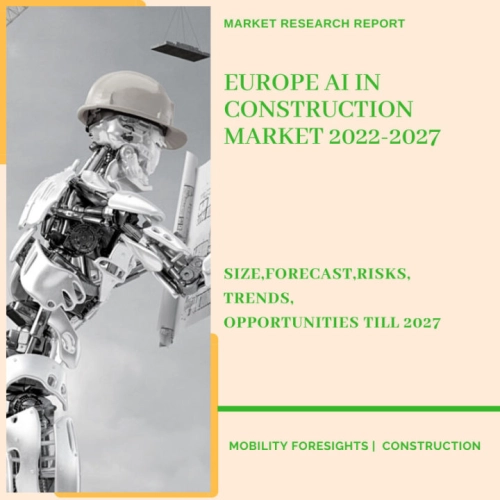
- Get in Touch with Us

Last Updated: Apr 25, 2025 | Study Period: 2022-2027
Robotics, artificial intelligence, and the Internet of Things can save construction costs by up to 20%. Engineers can wear virtual reality goggles and dispatch mini-robots into under-construction buildings.

These robots utilise cameras to monitor the progress of the work. In modern structures, artificial intelligence is being utilised to plan the routing of electrical and plumbing systems.
AI is being used by businesses to construct workplace safety solutions. Artificial intelligence (AI) is being used to track the real-time interactions of personnel, machinery, and items on the job site and warn supervisors of potential safety hazards, construction errors, and productivity concerns.
The Europe AI in Construction Market accounted for $XX Billion in 2021 and is anticipated to reach $XX Billion by 2026, registering a CAGR of XX% from 2022 to 2027.
The British-Israeli start-up is based in London. In Europe, Buildots has begun to use AI for construction sites. Construction delays and faults are automatically flagged using image recognition software.
An Israeli-British startup Buildots is working on an image recognition system that monitors every detail of a construction project and detects issues before they become a problem.
Even the largest construction sites are usually supervised by a small group of managers. Construction sites demand a level of control that people cannot provide.
Buildots' artificial intelligence for building can save a lot of money and is already being used. It is already being employed by two of Europe's largest construction companies, notably Wates of the United Kingdom, in a number of large residential projects.
| Sl no | Topic |
| 1 | Market Segmentation |
| 2 | Scope of the report |
| 3 | Abbreviations |
| 4 | Research Methodology |
| 5 | Executive Summary |
| 6 | Introduction |
| 7 | Insights from Industry stakeholders |
| 8 | Cost breakdown of Product by sub-components and average profit margin |
| 9 | Disruptive innovation in the Industry |
| 10 | Technology trends in the Industry |
| 11 | Consumer trends in the industry |
| 12 | Recent Production Milestones |
| 13 | Component Manufacturing in US, EU and China |
| 14 | COVID-19 impact on overall market |
| 15 | COVID-19 impact on Production of components |
| 16 | COVID-19 impact on Point of sale |
| 17 | Market Segmentation, Dynamics and Forecast by Geography, 2022-2027 |
| 18 | Market Segmentation, Dynamics and Forecast by Product Type, 2022-2027 |
| 19 | Market Segmentation, Dynamics and Forecast by Application, 2022-2027 |
| 20 | Market Segmentation, Dynamics and Forecast by End use, 2022-2027 |
| 21 | Product installation rate by OEM, 2022 |
| 22 | Incline/Decline in Average B-2-B selling price in past 5 years |
| 23 | Competition from substitute products |
| 24 | Gross margin and average profitability of suppliers |
| 25 | New product development in past 12 months |
| 26 | M&A in past 12 months |
| 27 | Growth strategy of leading players |
| 28 | Market share of vendors, 2022 |
| 29 | Company Profiles |
| 30 | Unmet needs and opportunity for new suppliers |
| 31 | Conclusion |
| 32 | Appendix |